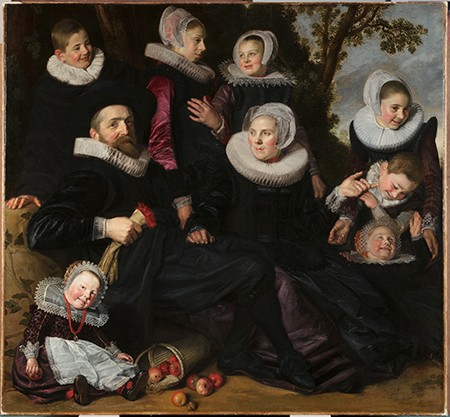One of the greatest portraitists of all time, and with Rembrandt van Rijn (1606–1669) the leading portraitist of seventeenth-century Holland’s Golden Age, Frans Hals (1582/1583–1666) painted individual portraits, pendant portraits, and two solitary double portraits as well as his renowned group portraits, including militia companies/civic guards, syndics, and regents of charitable organizations (almshouses, hospitals). In addition, Hals is known to have painted four family group portraits.
The earliest of the family portraits—until recently referred to as Family Portrait in a Landscape and for a number of decades on loan to the National Gallery of Wales in Cardiff from its former owner, the eleventh Viscount Boyne—was acquired by the Toledo Museum of Art in 2011. After its appearance at auction in Leiden in 1829, the painting was first published by Hofstede de Groot in 1910 and more fully by him in 1921. In 1929 it was included in the Royal Academy of Arts Exhibition of Dutch Art, 1450–1900. An article published by Leo van Puyvelde that same year noted similarities between Family Portrait in a Landscape and a painting
Two discoveries since the Toledo purchase have shed additional light on Hals’s original composition. As a result of archival research, Pieter Biesboer has established the identity of the subjects as the Haarlem cloth merchant Gijsbert Claesz van Campen, his wife, and their fourteen children. Second, lengthy conservation treatment of Three Children of the Van Campen Family with a Goat Cart, carried out in Brussels and completed in late spring 2016, has provided visual evidence that three more figures were included in Hals’s original composition, the head of one of them, a boy, existing today in a private collection. The remainder of the canvas, which would have included the other family members, sadly is lost.
It is in this context of our scholarly understanding concerning one of Hals’s family group portraits that I am co-organizing the exhibition Frans Hals Portraits: A Family Reunion, which will be on view at the Toledo Museum of Art (autumn 2018), the Royal Museums of Fine Arts Belgium, Brussels (winter 2019), and the Museo Nacional Thyssen-Bornemisza, Madrid (spring 2019). The exhibition will unite for the first time the three surviving components of the work now called The Van Campen Family Portrait in a Landscape (c. 1623–1625). In addition, all three of Hals’s other family group portraits are to be included: Portrait of a Dutch Family (c. 1635; Cincinnati Art Museum); Family Group in a Landscape (c. 1645–1648; Museo Nacional Thyssen-Bornemisza, Madrid); and Family Group in a Landscape (c. 1647–1650; National Gallery, London).
My fellowship at CASVA was devoted to researching and writing an essay, “Frans Hals—The Family Portraits,” which will form part of the exhibition catalog. Most seventeenth-century Dutch family group portraits by artists such as Pieter Fransz. de Grebber (c. 1600–1652/1653), Thomas de Keyser (1596/1597–1667), Jan Daemen Cool (c. 1589–1660), Adriaen van Ostade (1610–1685), and Jan Mijtens (1613/1614–1670) featured a family in either a domestic interior setting or a parkland, the likes of which could be found outside Dutch cities. In the main, they are conceived in a mode that is fundamentally and intentionally lacking the appearance of spontaneity. In contrast, the genius of Hals’s family group portraits, their compositional contrivance notwithstanding, is that, through their inward focus and deliberate theatricality, they convey to us over the centuries the fleeting moment of lifelikeness. It is this sense of
